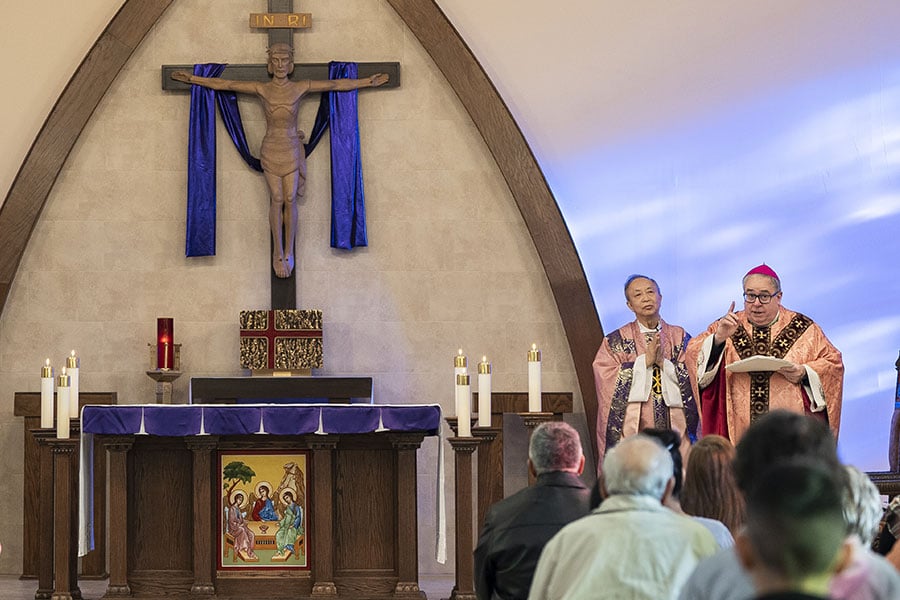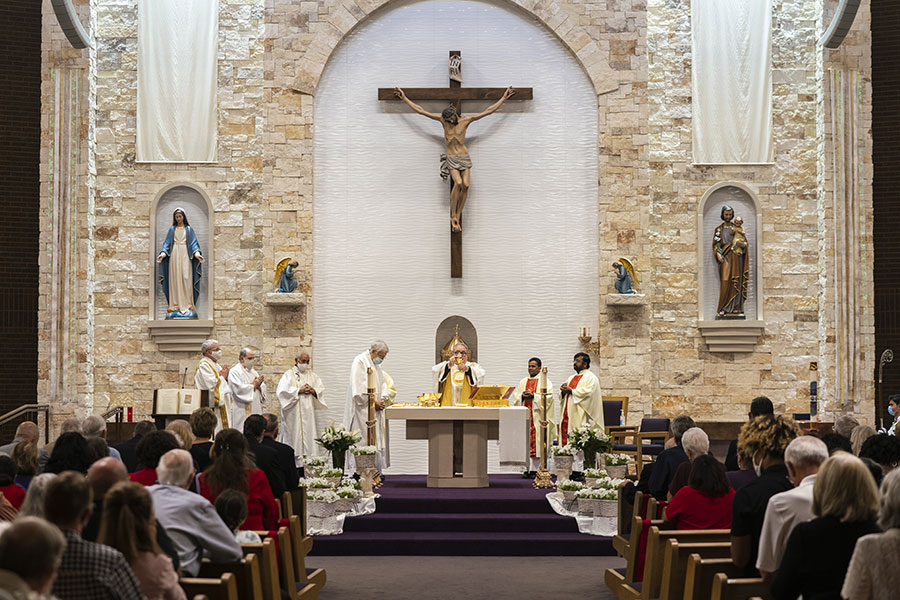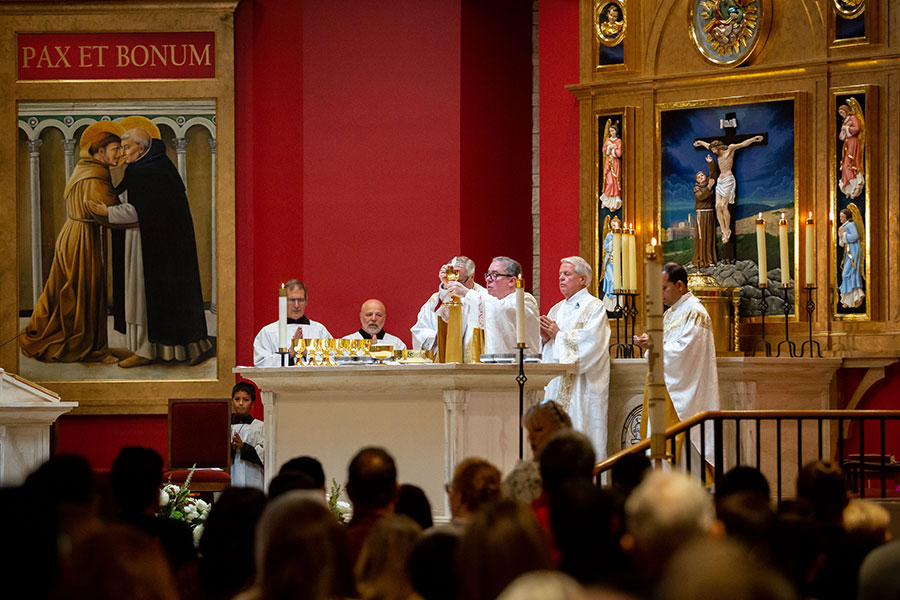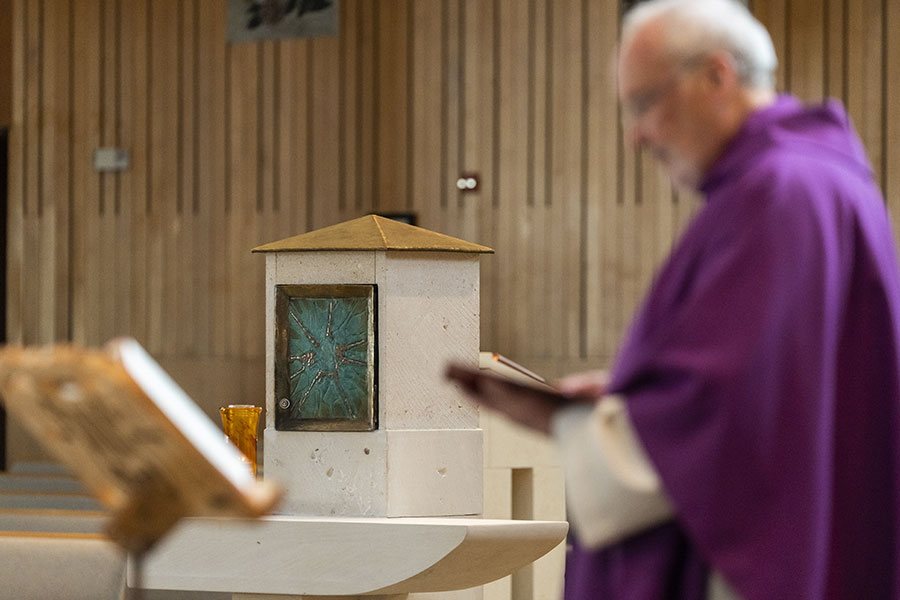Houses of worship centered on Christ

Bishop Michael Olson speaks to parishioners at St. Paul the Apostle Church in River Oaks on March 19. Bishop Olson blessed the new altar, ambo, and pews at the church during Mass. (NTC/Juan Guajardo)
More photos of parish sanctuary renovations
Renovations and other changes in several parishes within the Diocese of Fort Worth over the past few years have enhanced aesthetics and in some cases accessibility. Although both results are worthwhile, the primary goal behind the changes, parish priests said, has been to augment the worship experience and particularly focus on the tabernacle and the real presence of Christ in the Eucharist.
With these changes, leaders hope to reinforce the central tenet of Catholicism that, during consecration, the bread and wine become the Body and Blood of Jesus Christ as opposed to merely symbols of His sacrifice, and that the Eucharist is the “source and summit” of Christian life. Only 31 percent of self-described U.S. Catholics profess these truths, according to a 2019 Pew Research Center survey.
The most recent renovations occurred at St. Paul the Apostle Church in River Oaks, culminating with a March 19 blessing by Bishop Michael Olson.
At that parish, the tabernacle remains where it’s always been located, in the middle of the sanctuary behind the altar, St. Paul Pastor Thu Nguyen said. Additional renovations, however, enhanced both the church’s physical and spiritual attributes.
“When I first came in July, the pews did not have kneelers,” Father Nguyen said. “So we recently installed 32 pews with kneelers.”
Older pews (the parish dates to 1952) had been replaced about six years ago.
“A protestant church donated the pews, which didn’t have kneelers, before we got the new ones,” Fr. Nguyen said. “So our parishioners had been kneeling on the hard floor for over five years.”

The changes didn’t stop with the pews.
“At the same time, the altar was flimsy so we got a new altar, a new ambo, and a new candlestand for seven candles,” Fr. Nguyen said. “A piece of marble from the former altar was consecrated with a relic from the original church. That marble piece was inserted into the new altar and was there when we blessed it.”
Bishop Olson on March 19 blessed the altar, ambo, and pews.
“Several parishioners have said they like the new kneelers, that everything is much more comfortable now,” Fr. Nguyen said. “Bishop Olson commented on how beautiful the new altar is and the other changes.”
The projects cost about $85,000.
“We did fundraising events throughthe Advancement Foundation, the parish annual festival, and donors,” Fr. Nguyen said.
In the last few years, through funds on hand and/or capital campaigns, St. Michael in Bedford, Good Shepherd in Colleyville, St.Stephen in Weatherford, St. Francis of Assisi in Grapevine, St. Vincent de Paul in Arlington, St. Bartholomew in Fort Worth, and Holy Trinity in Azle — among other parishes — have also undergone renovations, most of which included tabernacle relocations.
In February 2022, workers relocated Good Shepherd’s tabernacle from a small chapel near the back of the church to the sanctuary.
“We didn’t get a new tabernacle,” said Father Michael Higgins, TOR, pastor of Good Shepherd. “We used the tabernacle that was in the chapel and put it on a stand constructed in the sanctuary that was designed by the architect who designed the church. That way it fits the design of the ambo, altar, and so forth, and looks like it was there from the beginning.
“That was my goal. I didn’t want it to look like an add-on.”
Placement of the tabernacle should be either in the sanctuary, though apart from the altar of celebration, or in a chapel “suitable for the private adoration and prayer of the faithful,” according to the General Instruction of the Roman Missal (315).
Fr. Nguyen, who also serves as diocesan director of Liturgy and Worship, discussed the history of the tabernacle and its importance in worship.
“We want the focus on God, not on us,” Fr. Nguyen explained. “The faithful come to church and they have to recognize the presence of Christ.”
The Most Blessed Sacrament, according to the guidelines, “should be reserved in a tabernacle in a part of the church that is truly noble, prominent, conspicuous, worthily decorated, and suitable for prayer” (314).
The tabernacle “should usually be the only one, be irremovable, be made of solid and inviolable material that is not transparent, and be locked in such a way that the danger of profanation is prevented to the greatest extent possible” (314).
For a church to have a tabernacle in both the sanctuary and an adoration chapel would require the bishop’s permission, Frs. Nguyen and Higgins added.
Good Shepherd’s tabernacle has always, as far as he knows, been in the chapel, Fr. Higgins said.
Fr. Higgins, through a letter to parishioners, outlined theological reasons for relocating the tabernacle and stressed that the relocation was in no way a negative comment on those who designed the church.
“The intent for them was having a separate chapel to highlight the importance of the Eucharist,” Fr. Higgins said. “But I don’t think it was doing what they hoped it would do.
“Part of the [reason for the] move was the decline in the belief or understanding in the real presence of Christ in the Eucharist over the years,” the pastor explained. “With the tabernacle being in a separate chapel, you could, in a sense, say people perceived it as, ‘Well, that’s not important. They just put it in a corner.’”

When St. Michael Parish in Bedford renovated its sanctuary, the altar, crucifix, and tabernacle were moved front and center. In this 2021 photo, Bishop Olson celebrates a Mass blessing the altar, tabernacle, and statuary. (NTC/Juan Guajardo)
The tabernacle’s previous location required Eucharistic ministers to transport the Blessed Sacrament in a large ciborium from the chapel to the main altar for daily and Sunday Mass.
“I didn’t see that as giving due dignity to the Eucharist,” Fr. Higgins said. “The constant movement back and forth to the tabernacle and the altar.”
Relocation of the tabernacle to Good Shepherd’s sanctuary has already brought positive effects.
“Before, because the tabernacle was not in the sanctuary, people were not genuflecting,” Fr. Higgins said. “Occasionally they would bow to the altar or cross, but that’s not genuflection. Now people are coming in and genuflecting to the tabernacle before they take their seats.”
Fr. Higgins added that each parish is different, of course, and that costs and architectural layouts may limit their renovation possibilities.
In 2018, St. Francis of Assisi in Grapevine, with a goal toward fulfilling their mission of “building a church of missionary disciples,” began a $5.7-million capital campaign for renovations and additions including renovation of the sanctuary and existing buildings, plus a new formation center and an adoration chapel.
“We pulled down the entire sanctuary,” Father Sojan George, pastor of St. Francis of Assisi, said. “Tore the whole thing down and rebuilt it, so a major renovation.”
The project included a new altar, ambo, and tabernacle, in addition to new artwork of St. Francis, mosaics, private confessionals, and the reintroduction of the church’s original stations of the cross.
“We relocated the tabernacle to the center,” Fr. George said. “It had been off to the side, so we wanted to bring it to the center, to make it the center of our worship and stress its importance as the source of our faith.”
A three-year project at St. Michael in Bedford reached fruition on Sept. 25, 2021, as Bishop Olson blessed the parish’s newly completed altar, tabernacle, and statuary on the Feast of St. Michael.
Parishioners representing 42 nationalities helped raise funds for the renovations through selling traditional foods, in addition to donations and other fundraising efforts. Because of them the chancel (space around the altar) received many “reverent and liturgically beneficial changes,” former St. Michael Pastor Balaji Boyalla, SAC, said.

“Previously, the altar was to one side, the crucifix to one side, and the tabernacle just on a plank,” Fr. Boyalla said.
“We wanted to give more focus to the Eucharist because we’re also celebrating, as the bishop says, that the Eucharist unites us. So, we wanted to put the altar, tabernacle, and crucifix on the same [center] line. Now, as people come in, they automatically go on their knees to genuflect and it gives us a more traditional look and more importance is given to the Holy Eucharist, the presence of Jesus,” said the former pastor.
The renovation addressed logistical issues as well.
“The ambo moved from the right side of the altar, as you enter, to the left,” Fr. Boyalla said. “We added a ramp on that side because many of our lectors are senior people who had difficulties with the steps but still wanted to do the readings.”
The tabernacle is new — the former one is now in the adoration chapel — as is the crucifix, the new cross made by a parishioner and the corpus coming from Italy, like the new statues of the Blessed Virgin Mary and St. Joseph. The former statues and crucifix now call the narthex home.
“To be frank, not even a single person said anything negative about the changes,” Fr. Boyalla said. “Rather, feedback has been that they are so happy.
“That is so perfect because, since the pandemic, a lot of people show more interest in watching Mass online. But we want them to get up and come and receive Communion and I think these renovations have definitely helped in getting people back to the church and helped increase worship focused on the Holy Eucharist.”
